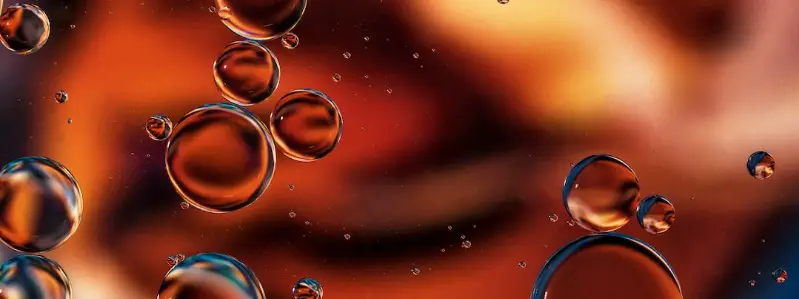Here’s Why Oil Does Not Dissolve in Water
Table of Contents
There’s a perfectly good explanation for why oil and water do not mix. It all comes down to chemistry.
The water molecule has many special properties that make life possible on this planet. It has a high heat index, and high surface tension, and is often called the universal solvent. There are plenty of things that will dissolve in water – most salts and sugars do. However, as anyone who has had to wash greasy dishes knows – oil and water do not mix. There’s a reason for that. Chemistry can explain why oil won’t dissolve in water.
Water is a Polar Molecule
Water is a polar molecule and this is a key reason for water and oil not mixing. Polarity means one end is positively charged while the other end is negatively charged. Dr. Kent Simmons explains the water molecule on his webpage “Polar Bonds of Water”. The water molecule is made of two hydrogen atoms and one oxygen, but the atoms are not arranged in a neat line. Rather, the two hydrogen atoms cling to one side of the oxygen, looking similar to a Mickey Mouse head. The electrons in the molecule spend more time on the oxygen side of the molecule, giving this side a negative charge and the hydrogen side a positive charge.

The Importance of Water Polarity in Dissolving Oil
Water is an excellent solvent because of its polarity. However, as the University of Southern Maine explains on its “Solvents” page, in general, only other polar molecules will dissolve in water. They call this the “Like dissolves like” adage. Polar molecules will dissolve in polar solvents and non-polar molecules will dissolve in non-polar solvents. Estrella Mountain Community College offers a picture of a polar salt molecule dissolving in water on their page “Chemistry II: Water and Organic Molecules”. The salt, NaCl, is attracted to the water molecules so that the positive Na+ ion is pulled by the negative side of a water molecule while the negative Cl- ion is pulled by the positive side of a water molecule.
Oil Does Not Mix With Water Because of Polarity
Oil and water don’t mix because oil is made up of non-polar molecules while water molecules are polar. Estrella Mountain Community College explains how water molecules are attracted to other water molecules and thus exclude the oil molecules which are not electrically charged. This exclusion causes the oil molecules, or lipids, to clump together. Ultimately, the fact that water and oil don’t mix is due to the polarity of the molecules. This affects people’s daily life and is the reason people use soaps and shampoos when cleaning.
Oil and Water Science Experiment for Kids
The following simple experiment includes combining equal amounts of oil and water, followed by a drop of food coloring. The water-based drop remains intact until it dips through the oil and comes into touch with water, at which point the color finally disperses. Because it lacks polarity (another topic for another day), the oil remains separate from the water and floats because it is less dense.
Understanding density will allow your children to get the most out of the experiment, so here’s a quick rundown. Assume you have two objects of the same size but different weights. The one that weighs heavier contains more matter. It is thicker. Putting something in the water is a nice approach to see if it is more or less dense than water. It is denser if it sinks, and less dense if it floats.
This is a basic experiment with amazing results and scientific principles. The color explosion that occurs as the food coloring passes through the oil will delight children. You’ll appreciate how simple it is to set up and clean up.
What will happen when you mix oil and water together
You will need: Several drinking glasses, vegetable oil, water, liquid food coloring, and a toothpick
Fill the drinking glass with roughly 12 cups of oil.
Fill the glass with an equal amount of water.
Take note of how the two split.
Explain density and then ask which is denser, water or oil (oil floats, indicating that it is less dense than water).
Inquire what happens if you add one drop of water-based food coloring to the oil.
Allow the youngster to place a drop in and observe (if the drop needs encouragement to move downward, use a toothpick)
Again, which is denser, the water-based drop or the oil (the water-based drop sinks, indicating that it is denser than the oil)?
The testing has just begun!
In reality, this is when science begins to take shape. Children will want to expand on this activity by adding more or different colors to the oil and water (perhaps to the one they already started to see how colors to mix, perhaps to a fresh cup). They might use a different cup size or shape, different amounts of oil and water, and they might even ask some really interesting questions like, “Food coloring doesn’t mix with oil, but what does it mix with?” Whatever they do, it’s all in the cause of science, and by encouraging their experimentation, you’ll be contributing to their scientific advancement.
